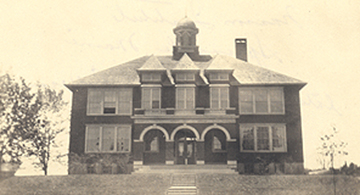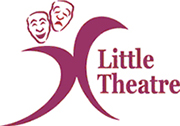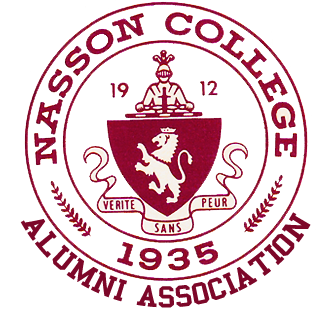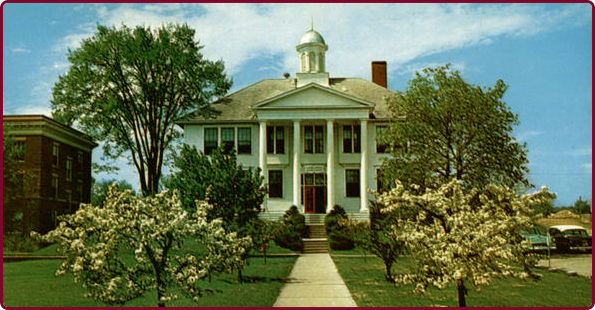History
In the beginning
Nasson College began in 1912 as Nasson Institute, a two-year program for women. It became a four-year college in 1935, and first admitted men in 1952.
After turning co-ed, Nasson quickly grew into a well-respected, four-year accredited liberal arts college, reaching a student enrollment of over 900 in the late 1960s.  Nasson offered majors in such fields as Biology, English, Environmental Science, Government, History, Mathematics, Medical Technology, and many more subjects.
Nasson offered majors in such fields as Biology, English, Environmental Science, Government, History, Mathematics, Medical Technology, and many more subjects.
On a 280-acre campus in the village of Springvale, Maine, the campus included a learning resources center housing the library (115,000 volumes and 950 current periodicals) and audio-visual services; a science center equipped with a rooftop greenhouse, radiation laboratory and laboratories for the sciences; a gymnasium, little theatre, dining commons, classroom buildings, health clinic, and student center. Nasson had a total of 11 residential units ranging from small frame houses to large dormitories.
 There was also Holdsworth Park, a five-acre area on the banks of the Mousam River, the Chapman Brook Park, with an outdoor skating rink; basketball and volleyball courts, and tennis courts. The Beaver Hill area included the Hilltop House social venue and a ski area, while field sports were played at Shaw Field.
There was also Holdsworth Park, a five-acre area on the banks of the Mousam River, the Chapman Brook Park, with an outdoor skating rink; basketball and volleyball courts, and tennis courts. The Beaver Hill area included the Hilltop House social venue and a ski area, while field sports were played at Shaw Field.
One of the best things about Nasson throughout its history was its size. Students, faculty and administrators could really get to know each other as individuals, and care about one another as individuals.
The New Division
In 1963, President Roger C. Gay proposed having two or more colleges under the banner of Nasson College. In the fall of 1966 the New Division, an experimental college, became a reality. The aim was to provide a liberal education involving extensive student participation in social, academic and discipline policy. Independent study was in provinces of knowledge, not in individual courses. However, by the end of the decade, poor planning led to many problems and that led to the end of this experimental program.
Nasson never recovered from these events. Eventually, changing demographics and more poor planning led to a declining enrollment, and the school eventually closed in 1983.
News since the closing
In December, 1984, most of the main campus was purchased, and soon "reopened" as "Nasson College." By 1985, there were again students walking the campus in Springvale, Maine. Operating primarily out of the old library, the new school called itself "Nasson College," and in 1989, celebrated the "75th Commencement" ceremonies.
But this school was not the same. There were no boarding students, no food services, sports teams, or clubs or activities. Moreover, the new Nasson never regained full accreditation, so the school could not return to its former status. Consequently, the school withered and eventually faded from existence. Numerous law suits followed.
Saving the campus
In the last few years before the school closed in 1983, there was a concerted effort by the administration to improve the look of the campus. Long-deferred maintenance was completed. It is ironic that the campus looked better on the day the college closed than it did on any day in the previous few years.
The money spent may not have proved helpful in efforts to save the school, but it had a definite long-term benefit. Once the school closed, most of the buildings were left vacant, unused, unheated. A few buildings were utilized in some way - Alumni Hall, the library, Marland Hall for a short time. But most of the buildings remained vacant and deteriorating - Brown Hall, Allen Hall, the Dining Commons, the gym, and so on.
Another new life
In 1996, the town of Springvale and the "University of Maine System—Sanford Center" rehabilitated the old library and once again doors were opened to students on the old campus.
But again, this was not meant to be a regular college, as many of the classes were taught only by television or computer. This time the brochures of the school made no mention of the old college, although the old library was pictured on the front of the school's brochure.
By the late 1990s, the campus buildings were resold, the bankruptcy cases were finally resolved, and the buildings were finally ripe for redevelopment. Brown Hall and Alumni Hall were put to new uses, as was the Anderson Learning Center. Others had emerging plans such as the Memorial Student Activity Center (the gym) and Marland Hall.
Interesting facts: total cost of tuition, room and board, and fees
In 1945: $663.50
In 1955: $1,085
In 1965: $2,265
In 1974: $3,900
In 1982: $7,695
The Nasson College Alumni Association today
Throughout all this time, the Nasson College Alumni Association remained active, meeting regularly and holding popular events such as Homecoming every fall, and Alumni Day every spring. Additionally, the Association sponsors a Concert and Lecture Series during the year as part of its mission. Through the efforts of many alumni, former faculty, the Sanford/Springvale Development Corporation, and local residents, a large room in the lower level of the Anderson Learning Center was renovated and made available to the alumni. The Nasson Heritage Center was dedicated on May 2, 1998. From that day forward, it has been the home of Nasson memorabilia and records and the gathering place for alumni, faculty, and friends throughout the year, as well as the meeting place for the Board of Directors and the Administrative Committee.
For a complete history of the college and subsequent events, see
Nasson, the Seventy Years, Albert L. Prosser, with an epilogue by Richard D'Abate (Phoenix Publishing 1993)
College For Sale: the Fall and Rise of a Closed College Campus, Richard E. Schneider (iUniverse 2012).

